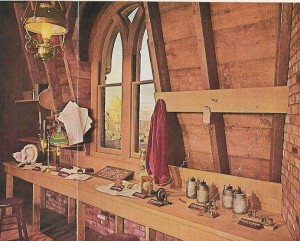 Birthplace of the Telephone – From this attic room on June 3, 1875, Alexander Graham Bell first sent speech sounds over a wire electrically. The telephone was born!At that time this room was located on the fifth floor of a building owned by Charles Williams, Jr. at 109 Court Street (now the John Fitzgerald Kennedy Federal Office Building), Boston. When the building was demolished in the late 1920’s, each piece of wood in the attic room was carefully removed, numbered and noted on precise plans. The window was preserved intact. Thomas A. Watson, Dr. Bell’s assistant, authenticated each of the drawings, and the timbers, rafters, sheathing and floor boards were carefully stored in a telephone company building. In 1959, working from the original plans, the room was reassembled in the lobby of the New England Telephone and Telegraph Company Headquarters building at 185 Franklin Street, Boston. Opened to the public on June 3, the 84th anniversary of the telephone’s birth, the room appears as it looked in October of 1875 when Dr. Bell was preparing sketches and models for the first telephone patent which was granted March 7, 1876. Although original wood and plans for reassembly were readily available, exhaustive research became necessary to recreate the room as Dr. Bell knew it. Consulting old city maps and drawings of buildings in the area resulted in recreating the view from the workshop window. The diorama is not only historically accurate, but lighting effects permit the scent to be displayed as it looked at any particular time of day or night.The work bench and shelves were temporary and were used for only ten months. Using Dr. Bell’s testimony in the patent cases and Mr. Watson’s memoirs as authority, the bench and materials on it were recreated. All of the models and replicas were constructed by the Bell Telephone Laboratories from original drawings furnished by Dr. Bell. The books and other reference mat
Birthplace of the Telephone – From this attic room on June 3, 1875, Alexander Graham Bell first sent speech sounds over a wire electrically. The telephone was born!At that time this room was located on the fifth floor of a building owned by Charles Williams, Jr. at 109 Court Street (now the John Fitzgerald Kennedy Federal Office Building), Boston. When the building was demolished in the late 1920’s, each piece of wood in the attic room was carefully removed, numbered and noted on precise plans. The window was preserved intact. Thomas A. Watson, Dr. Bell’s assistant, authenticated each of the drawings, and the timbers, rafters, sheathing and floor boards were carefully stored in a telephone company building. In 1959, working from the original plans, the room was reassembled in the lobby of the New England Telephone and Telegraph Company Headquarters building at 185 Franklin Street, Boston. Opened to the public on June 3, the 84th anniversary of the telephone’s birth, the room appears as it looked in October of 1875 when Dr. Bell was preparing sketches and models for the first telephone patent which was granted March 7, 1876. Although original wood and plans for reassembly were readily available, exhaustive research became necessary to recreate the room as Dr. Bell knew it. Consulting old city maps and drawings of buildings in the area resulted in recreating the view from the workshop window. The diorama is not only historically accurate, but lighting effects permit the scent to be displayed as it looked at any particular time of day or night.The work bench and shelves were temporary and were used for only ten months. Using Dr. Bell’s testimony in the patent cases and Mr. Watson’s memoirs as authority, the bench and materials on it were recreated. All of the models and replicas were constructed by the Bell Telephone Laboratories from original drawings furnished by Dr. Bell. The books and other reference mat erials were assembled after intensive research. Among these is Bell’s Standard Elocutionist by Dr. Bell’s uncle and his father — and Helmholtz’s Theorie Physiologique de La Musique in French.
erials were assembled after intensive research. Among these is Bell’s Standard Elocutionist by Dr. Bell’s uncle and his father — and Helmholtz’s Theorie Physiologique de La Musique in French.
The bricks composing one wall were obtained from a building knows to be in existence in 1870 and conform to Mr. Watson’s statement of their color.
Built into one wall of the room is a trophy case displaying the most significant items associated with early telephone history. Among these are the world’s first telephone switchboard operated by E. T. Holmes at 342 Washington Street, Boston in May of 1877 and the world’s first commercial telephone which was located in Charles Williams’ shop and connected to the Holmes switchboard. Replicas of the first telephones to carry intelligible speech and reproductions of the first telephone patent and blueprints from which the room was reassembled are also displayed.

